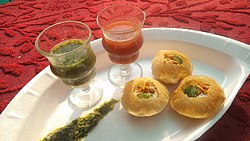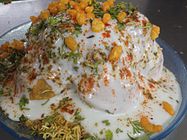Dahi puri
 Dahi puri, a common street food. | |
| Place of origin | India |
|---|---|
| Region or state | Maharashtra region of the Indian subcontinent |
| Associated national cuisine | India, Nepal, Bhutan |
| Main ingredients | Sev, puri, onion, chili powder, moong dal, dahi (yogurt) and coriander leaves |
| Variations | Sev puri, Dahi batata puri |
Dahipuri, or dahi puri,[1] is a snack, originating from India, which is especially popular in the state of Maharashtra, India. The dish is a form of chaat and originates from the city of Mumbai.[2] It is served with mini-puri shells (golgappa), which are more popularly recognized from the dish pani puri. Dahi puri and pani puri chaats are often sold from the same vendor.
Preparation[]
The round, hard, puffy puri shell is first broken on top and partially filled with the main stuffing of mashed potatoes or chickpeas. This dish must never be served cold. A small amount of haldi powder or chilli powder, or both, may be added for taste, as well as a pinch of salt. Sweet tamarind chutney and spicy green chutney are then poured into the shell, on top of the stuffing. Finally, sweetened beaten yoghurt is generously poured over the shell, and the finished product is garnished with sprinklings of crushed sev, moong dal, pomegranate and finely chopped coriander leaves.
Dahi puri typically comes as 5 or 6 dahi puris per plate. While pani puri is typically served one piece at a time,[original research?] a plate of many dahi puri is often served together. Each dahi puri is intended[by whom?] to be eaten whole, like pani puri, so that the spectrum of flavors and textures within may all be tasted together.
Home made dahi puri

A typical serving of dahi puri

Another style of serving
See also[]
- Bhelpuri
- Panipuri
- Papri chaat
- Ragda pattice
- Sevpuri
References[]
- ^ Forum. "Dahi Puri Recipe". Retrieved 2 September 2015.
- ^ Article on snacks of India
- Indian snack foods
- Pakistani snack foods
- Bangladeshi cuisine
- Street food
- Indian fast food
- Culture of Mumbai
- Yogurt-based dishes







